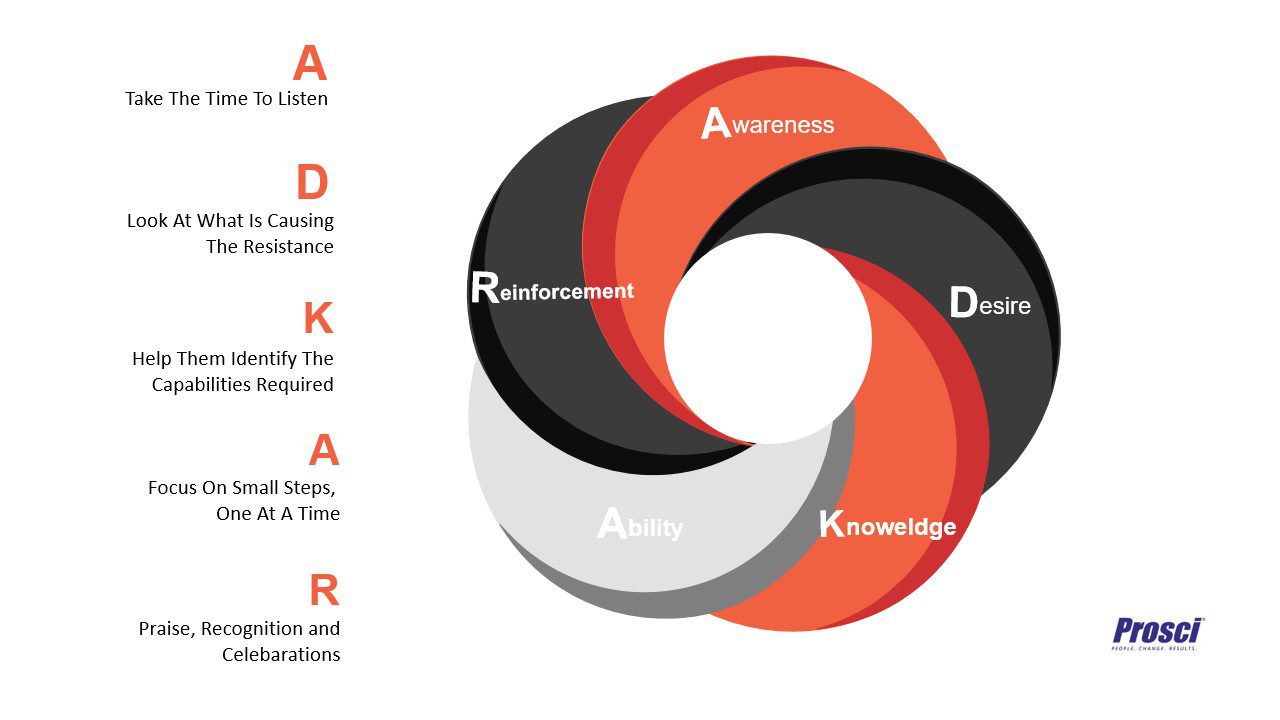What You Need To Know To Better Support Your Teams In Times Of Change
The world is experiencing the biggest change process that anyone has ever seen – Lockdowns, social distancing, being unable to do ordinary activities… Everything we always considered ‘normal’ is suddenly not so common anymore. Coaching through change is not always the easiest to navigate in rough water but after reading this blog you’ll feel more confident and walk away with some real tactical support to bring back to your team.
We know that change is inevitable in the world, and the same applies to business. As Kelly Smith, one of our Kolme OCM experts, explained in a recent Change Management blog Managing Change: Absent Processes Hurting Your Projects Future! Organizational Change Management (OCM) has been around for decades, but only recently began gaining global recognition. Due to this accelerated global interest, the ones who are managing change processes are experiencing a steep learning curve on what is required to make the change successful.
A tool that is of great benefit to the successful implementation of change management is coaching.
Why Should I Consider Coaching In The First Place?
Coaching is a very simple and practical method that provides you with your desired outcomes in a short timeframe.
It’s worth investing your time and effort into coaching, it focuses on solving problems with quick and clear results. Coaching provides a human touch to  your organizational change process by offering a 1:1 support system for the people involved and affected by the change. This strengthens the perception that they are not alone in this change, they have room to express their concerns and share their thoughts, and it helps to both build focus and motivate them to make the change successful for themselves.
your organizational change process by offering a 1:1 support system for the people involved and affected by the change. This strengthens the perception that they are not alone in this change, they have room to express their concerns and share their thoughts, and it helps to both build focus and motivate them to make the change successful for themselves.
Since coaching is spread out over a specific time-frame, rather than a single occurrence, it is basically an individual’s change process within a change process. Therefore, the effect of the change within the individual will be permanent as well.
How Does Coaching Fit In With OCM?
Founder of PROSCI® and OCM visionary, Jeffrey Hiatt, shares  that successful change is rooted in something very simple: how to facilitate change with one person. Being able to change that one person is your key to successful change. Read more about his ideas in his book ADKAR, A model for Change in Business, Government and our Community.
that successful change is rooted in something very simple: how to facilitate change with one person. Being able to change that one person is your key to successful change. Read more about his ideas in his book ADKAR, A model for Change in Business, Government and our Community.
Coaching complements this methodology, because it focuses on the change process of an individual. It supports each individual’s adoption process around the change that is happening. Sound like a match made in heaven…
Coaching serves as the ultimate support tool in transforming your OCM process into an even more people-oriented process.
After all, organizations do not make the decisions to change… people do!
It’s the people in an organization that add the heartbeat and make it a living structure. They need to be valued and supported in their change journey and that’s exactly what coaching is here for as it turns the focus on them, individually.
Suitable Areas For Coaching Within Your Change Management Process
At Kolme Group, we support the ADKAR® methodology for Organizational Change Management. ADKAR stands for the five objectives that must be achieved for any change to be successful.
Within each objective there is a way to incorporate coaching and further support the chances of successful implementation and sustained adoption of the change.

Awareness – of the need for change
Coaching people right from the start of the ADKAR process will help you gain awareness of how your teams view the current state and respond to the change the moment it is communicated.
Taking the time to listen to your team’s views and asking questions to discover why they respond the way they do is important. This will help to kickstart the ongoing conversation on their acceptance process of the awareness messages of why the change is happening and what the consequences are if the change does not happen.
Desire – to support and participate in the change
The desire to change depends on a person’s personal situation, amongst other factors. Concerns in this area which threatens the success of the change, can be coached in an early stage.
Looking at what is causing the resistance and discovering the underlying feelings can help to change a person’s view on how desirable the change actually is for them.
This also applies when the ‘What’s in it for me’ (WIIFM) is unclear or missing; coaching can help get a better focus on the personal gain of the change for each individual.
Knowledge – of how to change
Building knowledge depends on a person’s capacity and capabilities. Individuals that have the tendency to assume they do not have the capacity or capability to be educated on the knowledge involving the change, can be coached on this topic.
Helping them identify the capabilities required and helping them understand in which previous situations they already showcased these capabilities, creates a positive outlook on their learning required for the current change. It helps them focus and increase motivation to get it done.
Ability – to implement the required skills and behaviors
When it comes to putting the gained knowledge and behaviors in practice, coaching is very beneficial for those that have difficulties making that happen.
Coaching can help them focus on making a step-by-step approach of how they can implement the knowledge/behaviors required. Coaching focuses on small steps, one at a time, instead of taking a giant leap which is what people usually try to do.
Reinforcement – to sustain the change
Coaching, in itself, is already reinforcement. Especially if you use the solution oriented coaching method, reinforcement is a part that you apply throughout your coaching conversations.
Whenever you are using coaching in the last objective of the ADKAR methodology you reinforce the accomplishments achieved in the coaching throughout the previous four objectives.
Praise, recognition and celebrations are the most powerful ones to be used, as they focus on the positive side of change
How To Coach your Team in Change
Now that you know  how coaching can contribute to OCM and in what parts of its lifecycle you can apply it, let’s focus on what is important to know when you are coaching a team member.
how coaching can contribute to OCM and in what parts of its lifecycle you can apply it, let’s focus on what is important to know when you are coaching a team member.
Listen, Listen, Listen!
Did I mention, listening is key? Whatever you are doing during a coaching session, it all starts with good listening skills.
It’s called the art of listening for a reason, and that’s because good listening skills do not come easy and you will have to practice in order to master the skill.
Here are some recommended starting points:
- Ask open-ended questions – questions that cannot be answered with yes or no
- Prevent asking for the ‘why’ as much as you can – rather use ‘How’ or ‘How come’? This is because ‘why’ is calling for an explanation. Human feelings and experiences cannot always be explained, therefore, asking for the why can quickly push a person in a defensive mode. As a coach you do not want to go there!
- Summarize what you have heard – this demonstrates to the other person that you have been listening actively AND it is a way to check if you have understood correctly. Each individual has a different view of the world, and those can cause unintentional miscommunication between you and that other. Try this, “If I summarize what you have been telling correctly…”
- Make sure you have sufficient time available to provide the coaching session. You want to be in a place where you can devote your attention and give you both the time needed for communication without distraction.
Driving The Conversation Without Taking The Lead
- It is in the human nature to focus on the negative: failures, fears, what is NOT there, what CANNOT be accomplished.
- Let them get it off their chest (listen!), show empathy and start to focus on the positive – their previous accomplishments, current skills & talents.
- What IS already there and what they could gain from the change. Your guidance here will be important when your coachee keeps going back to the negative, which will happen.
- Do not get frustrated, it is the way we were created and luckily, we can change….
- It helps to ask about previous (or similar) situations that did end well. How did your coachee accomplish that, what skills did they used, how did that make them feel?
- Take them back in time and relive the experience, highlight those accomplishments, reinforce by praise, then make a bridge to the current situation and guide them on to see how that approach worked once, therefore they can make it work again.
Use The Golden Triangle: Think, Do & Feel Questions
People tend to have a favorite way of expressing themselves. There are people that think (intellect), there are people that feel (emotion) and there are people that take immediate action. Do not focus on their favorite aspect (the one that comes very naturally) but challenge them by asking for the 2 less favorite aspects.
For example:
You know that type of person that always tells you ‘I Think…’ or ‘I was thinking about that topic and…’
Ask that person how it feels: let them describe that feeling and ask where in the body they feel it. Or ask them to literally describe an experience in detail: how did the environment looked like? What were you seeing/hearing at that exact moment?
Take the opportunity to help them re-live their experience in all 3 ways (what were they thinking, feeling and doing) to help them better understand their underlying emotions and actions that are involved with the change they are going through.
This provides room to explore more about what needs to happen in order to approach the change successfully
Next Steps In Your Approach
As discussed, using coaching in your change management process is a great complement to help individuals overcoming change. Design your coaching plans with a clear hierarchy of roles – who is coaching who.
For example:
- Change Management consultant coaches the Sponsor
- Sponsor coaches the Direct Managers
- Each Direct Manager coaches the Team Leads
- Each Team Lead coaches their Team Members
Friendly reminder! Be sure that your ratio of coaches is small enough that each team member receives the required time and attention for a successful adoption of the change.
We’re Here to Help You Coach Better
At Kolme Group we care and want to help you get the best out of coaching your teams in times of change. We offer a free, 30-minute consultancy around basic coaching skills to the first 5 applicants. If you are interested, please register below.
Want to learn more on the fundamentals of Organizational Change Management, check out our webinar here.
Kolme Group has helped our clients with free Change Management assessments and high-level planning so they can focus the value of Change Management for their organization. Our experienced consultants see great value in using all the tools in our toolbox to make your projects thrive! To find out more about our Project and Change Management Services, please email us at PPManswers@kolmegroup.com.
Be sure to follow us on Twitter, LinkedIn and YouTube and use #KolmeGroup on shared posts!
